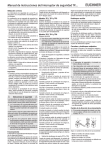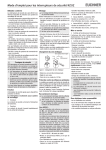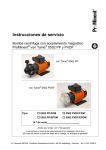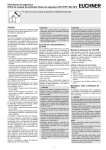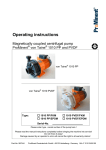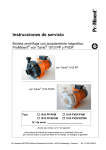Download Operating Instructions TP... Safety Switch
Transcript
Operating Instructions TP... Safety Switch Correct use Safety switches series TP are electromagnetic interlock devices with guard locking. They interlock movable safety guards so that dangerous work on machines can only be carried out if the safety guard is closed and locked. the safety guard cannot be opened when the machine is running. For the control system, this means that starting commands which cause hazardous situations must become active only when the safety guard is in protective position and the guard locking is in locked position. The locked position of the guard locking must be released only when the hazardous situation is no longer present. Before safety switches are used, a risk assessment must be performed on the machine in accordance with EN 954-1, Safety of machinery. Safety related parts of control systems. General principles for design, Annex B EN 1050, Safety of machinery. Principles for risk assessment IEC 62061, Safety of machinery - Functional safety of safety-related electrical, electronic and programmable electronic control systems. Correct use includes compliance with the relevant requirements for installation and operation, in particular EN 954-1, Safety of machinery. Safety related parts of control systems. General principles for design EN 1088, Safety of machinery. Interlocking devices associated with guards. Principles for design and selection EN 60 204-1, Safety of machinery. Electrical equipment of machines. General requirements. Safety precautions Safety switches perform a personal protection function. Incorrect installation or tampering can lead to severe injuries to personnel. Safety switches must not be bypassed (bridging of contacts), turned away, removed or otherwise rendered ineffective. The switching operation must only be triggered by actuators specifically provided for this purpose which are permanently connected to the safety guard. Mounting must be performed only by authorized personnel. Electrical connection must be performed only by authorized personnel. Function Safety switches series TP permit locking of movable safety guards. Position monitoring of the safety guard and monitoring of interlocking are performed via the same switching element. Version TP1 and TP3 (mechanically locked) The guard locking pin is held in locking position by spring force and released by electromagnetic actuation. The spring interlock guard locking functions in accordance with the closed-circuit current principle. The safety guard cannot be opened immediately in the event of interruption of the solenoid power supply. Versions TP2 and TP4 (solenoid interlock) This type may be used only in special cases after strict assessment of the accident risk! The safety guard can be opened immediately in the event of interruption of the solenoid power supply! The guard locking pin is held in locking position by electromagnetic force and released by spring force. The guard locking operates in accordance with the open-circuit current principle. Closing and locking The guard locking pin is released by insertion of the actuator into the safety switch. TP1 and TP3: The guard locking pin is moved to locking position by spring force. TP2 and TP4: The guard locking pin is moved to locking position when the solenoid operating voltage is applied. The safety contacts are closed. Unlocking TP1: The guard locking pin unlocks the actuator / safety guard to the Open switching position when voltage is applied to the solenoid (see Figure 2, column 3). TP2: The guard locking pin unlocks the actuator / safety guard to the Open switching position when voltage is removed from the solenoid (see Figure 2, column 3). TP3: The guard locking pin unlocks the actuator / safety guard to the Unlocked switching position when voltage is applied to the solenoid (see Figure 2, column 2). TP4: The guard locking pin unlocks the actuator / safety guard to the Unlocked switching position when voltage is removed from the solenoid (see Figure 2, column 2). The safety contacts are opened. Opening The guard locking pin is blocked when the actuator is pulled out. The safety contacts remain positively opened. Mechanical release Changing the actuating direction Figure 1: Changing the actuating direction Remove the screws from the actuating head. Set the required direction. Tighten the screws with a torque of 0.6 Nm. Cover the unused actuating slot with the enclosed slot cover. Increased overtravel of the actuator is possible only with the types TP...K... in the case of vertical approach direction. Protection against environmental effects A lasting and correct safety function requires that the actuating head must be protected against the penetration of foreign bodies such as swarf, sand, blasting shot, etc. Cover the actuating slot, the actuator and the rating plate during painting work! Electrical connection When choosing the insulation material and wire for the connections, pay attention to the overtemperature in the housing (depending on the operating conditions)! The operating voltage for the locking solenoid must match the value on the rating plate (e.g. US = AC/DC 24 V). Version TP.. (Cable entry M20x1.5 / Pg 13,5 / NPT ½") Break out the required insertion opening. Fit the cable gland with the appropriate degree of protection. For pin assignment see Figure 2. Tighten the screws with a torque of 0.5 Nm. Check that the cable entry is sealed. Close the cover and screw in position. In the event of malfunctions, the guard locking can be released with the mechanical release irrespective of the state of the solenoid (see Figure 3). Unscrew locking screw. Using a screwdriver, turn the mechanical release by around 180° in the direction of the arrow. The mechanical release or the mechanical key release must be returned to its original position and sealed after use (for example with sealing lacquer or using wire). Please observe the supplied dimension drawing in the case of mechanical key release. Version TP..SR.. (plug connector) For pin assignment see Figure 2. Only switching elements marked with the positive opening symbol shall be used for the safety circuit. For switching elements with four positively driven contacts only the contacts 21-22 and 41-42 are actuated on locking and unlocking the guard locking. In applications with potentially hazardous states (e.g. overtravelling movements), contact 21-22 and/or 41-42 must always be integrated into the safety circuit.“ Mounting Setup Assemble the safety switch so that access to the switch is difficult for operating personnel when the safety guard is open. it is possible to operate the mechanical release and check and replace the safety switch. Safety switches and actuators must not be used as an end stop. Fit an additional stop for the movable part of the safety guard. Mount the safety switch only in assembled condition! At ambient temperatures greater than 40 °C, the switch must be protected against contact with inflammable material or accidental touching. Insert the actuator in the actuating head. Mount the safety switch positively. Permanently connect the actuator to the safety guard so that it cannot be detached, e.g. using the enclosed non-removable screws, rivets or welding. Mechanical function test The actuator must slide easily into the actuating head. Close the safety guard several times to check the function. Electrical function test Close safety guard Activate guard locking It must not be possible to open the safety guard Switch on machine Switch off machine Deactivate guard locking It must not be possible to switch on the machine Open safety guard End command for deactivating the guard locking It must not be possible to switch on the machine Service and inspection Actuator: Switching position: Inserted Locked Inserted Unlocked v Removed Open h Type E1 E1 E2 E2 Pin assignment, plug connector E1 E2 SR6 TP1-528.. TP2-528.. TP1-538.. TP2-538.. TP3-537.. TP4-537.. TP1-4131.. TP2-4131.. SR11 No servicing is required, but regular inspection of the following is necessary to ensure trouble-free long-term operation: correct switching function secure mounting of components dirt and wear sealing of cable entry loose cable connections or plug connectors. If damage or wear is found, the complete switch and actuator assembly must be replaced. Replacement of individual parts or assemblies is not permitted! The complete safety switch assembly must be replaced after 1 million operating cycles. Exclusion of liability under the following conditions: if the unit is not used for its intended purpose non-compliance with safety regulations installation and electrical connection not performed by authorized personnel failure to perform functional checks. TP3-4131.. TP4-4131.. Technical Data TP3-2131.. TP4-2131.. TP3-4121.. TP4-4121.. Ordinal numbers of switching elements TP3-4141.. TP4-4141.. Figure 2: Switching elements and switching functions Necessary minimum travel + permissible overtravel Approach direction Standard actuator Actuator overtravel Horizontal (h) 28 + 2 28 + 7 Vertical (v) 29.5 + 1.5 only with TP...K... 29,5 + 7 50 42 3,5 199 v h Figure 3a: TP...K... 31 43 3,5 35 v h 192 for M5 > 35 mm ISO 1207 (DIN84) ISO 4762 (DIN 912) M = 1.5 Nm 144 Mechanical release M = 0.5 Nm 22 Locking screw Figure 3b: TP...A...M20x1,5 TP...A...Pg 13,5 TP...A...NPT½“ 16 30 40 M = 0.6 Nm 28 16 42 Parameters Value Housing material Reinforced thermoplastic Degree of protection according to IEC 60529 Cable entry IP67 Plug connector IP65 Mech. life 1x106 operating cycles Ambient temperature -20...+55 °C Degree of contamination (external, according 3 (industrial) to EN 60947-1) Installation position Any Approach speed, max. 20 m/min Actuating force max. 10 N at 20 °C Extraction force 20 N Retention force 10 N Locking force Fmax TP1/TP2/TP3/TP4 1300 N TP5/TP6 800 N Locking force Fzh in accordance with Test Principles GS-ET-19 F (FZh = max) = 1000 N TP1/TP2/TP3/TP4 1.3 TP5/TP6 – Actuation frequency 7000 / h Switching principle Slow-action switching element Contact material Silver alloy, gold flashed Type of connection TP... Screw terminal with cable entry TP...SR6 Plug connector SR6, 6-pin TP...SR11 Plug connector SR11, 11-pin Conductor cross-section 0.34 ... 1.5 mm² (rigid/flexible) Rated insulation voltage TP... , TP...SR6 Ui = 250 V TP...SR11 Ui = 50 V Rated impulse withstand voltage TP... , TP...SR6 Uimp = 2.5 kV TP...SR11 Uimp = 1.5 kV Switching voltage, min., 12 V at 10 mA Utilization category to EN 60947-5-1 TP... , TP...SR6 AC-15 4 A 230 V / DC-13 4 A 24 V TP...SR11 AC-15 4 A 50 V / DC-13 4 A 24 V Switching current, min., 1 mA at 24 V Short circuit protection 4 A gG according to IEC 60269-1 Conventional thermal current Ith 4 A Solenoid operating voltage/power input TP...024 AC/DC 24 V (+10%/-15%) 8 W TP...110 AC 110 V (+10%/-15%) 10 W TP...230 AC 230 V (+10%/-15%) 11 W Duty cycle 100 % 3,5 Figure 3c: TP...SR.. 8,5 SR Figure 3: Dimension drawing EUCHNER GmbH + Co. KG Kohlhammerstraße 16 D-70771 Leinfelden-Echterdingen Tel. +49/711/75 97-0 Fax +49/711/75 33 16 www.euchner.de [email protected] Subject to technical modifications; no responsibility is accepted for the accuracy of this information. © EUCHNER GmbH + Co. KG 084123-08-12/07 Operating Instructions TP... Safety Switch




